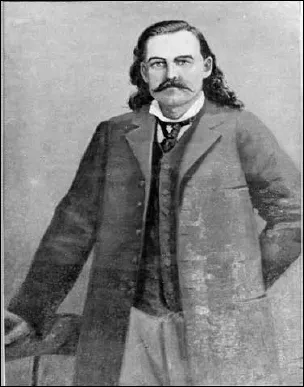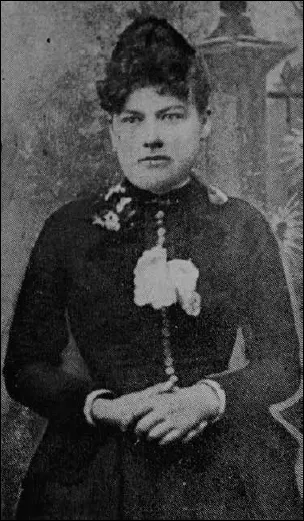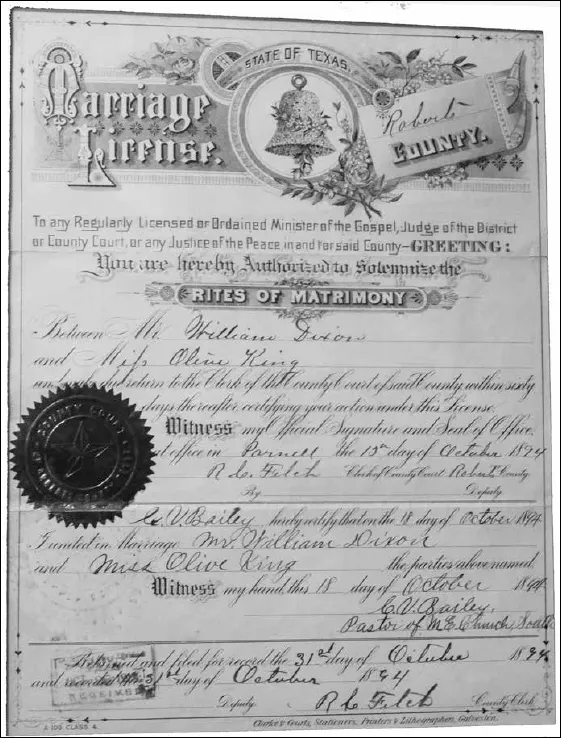![]()
Chapter One
A Panhandle Wedding
I was in love with the West . . .
Olive King
The bridegroom and preacher were late. It was Thursday afternoon, October 18, 1894 — the wedding day of Billy Dixon and Olive King. He was famous as a hero of Adobe Walls and a Medal of Honor winner for action in the Panhandle. She was an adventurous young schoolmarm who had come from Virginia to the Texas Panhandle to visit a cowboy brother. In the sparsely settled Panhandle cow country Billy and Olive found each other.
Olive King arrived in Texas in the spring of 1893. She was met at Canadian by her older brother, Archie King, a cowboy for the Bar CC Ranch. Archie had a wife and a baby boy whom Olive had never met, and he had invited his sister for a get-acquainted stay in a striking remnant of the Old West. Olive promptly fell in love with the Panhandle Plains. “Never had I seen such tall grass and such expanse of clouds and sky.” The scenery “was gorgeous, rich, fresh and clean . . .” The impact was immediate and permanent: “I loved the country from the first. Everyone was friendly and all were equal.”1
Olive responded warmly to the people of the Panhandle: cowboys, ranchers, ranch wives, her new sister-in-law Sena, and her little nephew, Woods King, named after her deceased father. There were camping and fishing trips with neighbors, a Fourth of July dance, a Thanksgiving dinner.
Despite Olive’s deep enjoyment of the Panhandle and its people, Sena became pregnant again and Olive began to feel that she should leave the sod home of her brother and his growing family. Reluctantly she contemplated returning to Virginia. But she was offered a teaching position at a tiny rural school located just south of the Canadian River. With an unexpected opportunity to stay in the Panhandle, Olive found lodgings just two-and-one half miles south of the little school with a family named Lewis. Late in November 1893 she met Billy Dixon, who lived just five miles away at Adobe Walls.2
Billy Dixon had striking good looks, with a sweeping moustache and the shoulder-length hair of a plainsman. Through permission from Virginia Irwin Maynard, Billy’s granddaughter.
Mrs. Lewis eagerly assumed the role of matchmaker. Although Billy was painfully shy around women, he soon adored the pretty young schoolmarm. Billy proposed to Olive in July 1894, and he wrote a letter to her mother, formally requesting Olive’s hand in marriage.3
By the time Mrs. King’s reply arrived a month later, wedding plans were well advanced by Olive and Mrs. Lewis. Since there were no churches in the area, Dixon suggested a civil ceremony by the nearest county judge or justice of the peace — an idea that was immediately vetoed by the ladies. Olive insisted on being married by a minister, and Mrs. Lewis offered her home for the ceremony and a wedding supper.
Dixon thought of Rev. C.V. Bailey, a Methodist circuit rider who headquartered in Mobeetie. Methodists had sent missionaries from the United States to Texas immediately following news of the Texan triumph at San Jacinto in 1836. Methodists industriously founded churches in Texas, organized circuits, and formed Sunday schools. During the 1880s, as railroads extended into northwest Texas, Methodists opened new churches in new communities and sent circuit riders into the Panhandle. On Sundays these traveling preachers customarily held services at two or three locations. Mobeetie was seventy-five miles from the Lewis home, but Reverend Bailey agreed to make the journey.4
Olive King at eighteen, two years before she came to Texas and three years before her wedding. Through permission from Virginia Irwin Maynard, Olive’s granddaughter.
Olive had sewn a light blue dress for the July Fourth celebration the previous year, and she and Mrs. Lewis began to convert it to a wedding gown with lace and ribbons and bows. The two women created a bridal trousseau, featuring the customary “second day dress.” Plans were made for the wedding supper, and for room and furniture arrangements. The Lewis home was a three-room picket structure, and the wedding would be held in the largest room.
On the day of the wedding Reverend Bailey drove up in a buggy, intending to head to Adobe Walls and bring the groom back in time for the four o’clock ceremony. During the afternoon Olive dressed and preparations were made for the wedding supper. Archie and Sena and their two small children arrived, and so did several neighbors.
But four o’clock came and went, and it was a long wait until twilight before the bridegroom and the preacher finally arrived. Reverend Bailey cheerfully assumed blame for the tardiness, admitting that he had insisted on a personal tour of the Adobe Walls battlefield and on visiting with Turkey Track cowboys who made an untimely stop at Billy Dixon’s store.
Billy, attired in a blue suit and black tie, and Olive in her wedding dress, at last took their positions before the preacher, who stood in front of a carefully decorated fireplace and mantle. Vows were exchanged and hearty congratulations were delivered. The wedding supper was a success, and a social hour followed. Soon the bridegroom suggested that it was time to head home, and as the newlyweds climbed into the buckboard they were the recipients of enthusiastic good wishes.5
The five-mile trail to Adobe Walls was quickly traversed. Billy carried Mrs. Dixon through the front door of her new home, unharnessed and fed his team, then joined his bride inside.
Billy was forty-five when he married; Olive was twenty-one. Despite their age difference, Billy and Olive proved to be soulmates. Billy was fit and handsome and strong. In early middle age he had fallen deeply in love; his passion and affection for Olive overcame his lifelong, crippling bashfulness around members of the opposite sex. Billy was a noted Panhandle pioneer of buffalo hunting days of the 1870s, as well as a renowned hero of Indian combat in the region.
Olive did not reach the Panhandle until the 1890s. There no longer was danger from Indian attack, but hardships remained part of everyday life. The population still was small and scattered. Although living conditions remained primitive with few amenities, “I was in love with the West and was ready and willing to meet any emergency in order to be able to stay in Texas.” During her first year she experienced storms, stampedes, and prairie fires, and during her first Thanksgiving a ferocious storm battered everyone with “hail, wind, rain, thunder and fierce lightning.” Stock animals were killed on the range, and a baby’s highchair was found miles down a creek lodged in the fork of a tree. Blizzards were a part of every Panhandle winter. “Many men and much stock were frozen to death every winter,” Olive reminisced matter-of-factly.6
Marriage license of William Dixon and Olive King. The signature of Rev. C.V. Bailey is toward the bottom. Bailey filed the license in Roberts County, where he lived. Courtesy Panhandle-Plains Historical Museum, Canyon, Texas.
Undeterred, Olive made her home in the Panhandle for the rest of her life. “For almost three years,” she frequently pointed out, “I was the only woman living in Hutchinson County.” Billy was proud that “my wife for a period of three years was the only woman who actually lived in Hutchinson County. She may have grown a bit lonesome,” he added, “but if she did she never said anything about it.”
Although created in 1876, Hutchinson County was so thinly settled that it was not organized until 1901, seven years after Billy and Olive married. Olive seemed proud of her “only woman” identity, because it lent credibility to her status as a Panhandle pioneer. And Billy liked to joke that early in their marriage he could say, “Without making any other men angry, that I had the best looking woman in the County.”7
Olive and Billy both were natives of Virginia. Her family was proud of its colonial roots in the first American colony. Olive’s great-great grandfather, Gen. Andrew Lewis, was a military hero of colonial Indian conflicts and of the American Revolution, and her father had served in the Confederate Army. Now, as a young woman, she had married a hero of the Panhandle Indian Wars and she was creating a home under pioneering conditions. “There were months when I did not see any living soul except my husband and the cowboys who rode the range.”8
In an interview given when she was seventy-three, Olive posed a rhetorical question: “Did I get lonesome and long for my Virginia home? Not at all. From the beginning I seemed to have fitted into this new life that was as foreign to the old life as day is to night. Never have I regretted that I came. I am proud of my native state, Virginia, and the part my forefathers played in the history of Virginia, but prouder still that I have been allowed to have a small part in the development of the state that has been my home for [more than] half a century.”9
Olive gave birth to eight children, each without the attendance of a doctor. She had lost her own father when she was seven, so perhaps Billy Dixon provided a bit of a father figure. But her admiration and adoration for this legendary frontiersman were unbridled. Olive persuaded her reticent husband to tell her stories from his frontier days, and she somehow found time to record his adventures. After Billy’s death she finished raising their children under difficult circumstances. But she also produced a book about his life, and she continued to write about Billy and other Panhandle pioneers for area newspapers.
As the Panhandle grew and matured early in the twentieth century, Olive worked to perpetuate her husband’s fame, securing monuments at Adobe Walls and at Buffalo Wallow, where he earned a Medal of Honor. Olive became a charter member of the Panhandle-Plains Historical Society and, through unrelenting effort, a force for Panhandle history. Finally settling in Amarillo, an urban center of the High Plains, she produced historical pieces about the Panhandle for the rest of her life, while attending and helping to stage historical events. It was a great satisfaction to Olive King Dixon that her children and grandchildren were “raised on history.”10
So two Virginia-born adventure-seekers found each other in the Texas Panhandle of the 1890s. They found marriage and a rich family life. Olive found a man worthy of deep esteem as well as of love and lifelong devotion. And Billy, a Panhandle icon of heroism, overcame his fear of females and found a sweetheart who would commemorate his remarkable deeds to future generations.
![]()
Chapter Two
The Mysterious Background of Billy Dixon
Go West, young man, and grow up with the country.
Horace Greeley
New York Tribune
The standard source for the early years of Billy Dixon’s life is the brief account of his origins which he related to his wife while she recorded his recollections. Billy always was known as taciturn, but he was especially close-mouthed about his childhood. In Life and Adventures of “Billy” Dixon, published by Olive a year after his death, all she was able to record about his origins was the following:
I was born in Ohio County, Virginia, September 25, 1850, the oldest of three children. My mother died when her third child was born . . . When I was twelve years old my father died, and with my sister I went to live with my uncle, Thomas Dixon, who lived in Ray County, Missouri. In those days travel was difficult, and Missouri seemed a long way from our home in West Virginia. We had been with our uncle only a few months when my sister was stricken with typhoid fever and died after an illness of about two weeks. This left me alone in the world. My uncle was kind and good to me, but I stayed with him only a year.1
Billy failed to mention the names of his father, mother, or the sister who supposedly died of typhoid fever. Indeed, his brief description of his boyhood is a collection of untruths. Census records reveal that he was the third child — not the first — born to William R. and Nancy Privett Dixon, and he was named after his father. Four more children subsequently were born to the couple, for a total of seven — four boys and three girls. William and Nancy were married in 1844, when he was twenty-four and she was sixteen. Their first child, Albert, was born the next year. Census records reveal that the Dixon children were Andrew (born in 1845), Sarah (1846), William R. “Bill...



